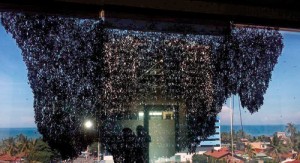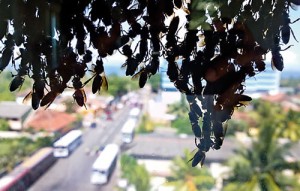News
The buzzing Vesak decoration on the 6th floor
Decorations adorn many buildings at Vesak – but the staff of an office in Dehiwela found a special decoration covering one of their 6th floor

The curtain of bees covering the Dehiwela office building window
windows: a close look revealed it was a swarm of bees spread like a curtain across a part of a large glass window.
The bees began arriving on the morning of Monday, April 27 around 8am. Soon hundreds, if not thousands of buzzing bees covered the window, said Rajiv Welikala who alerted wildlife enthusiasts about this unusual sighting.
“They are the giant honey-bee or ‘bambara’ in Sinhala – the same species that inhabits Sigiriya,” said bee specialist Dr. Wasantha Punchihewa who visited the site.
Contrary to the popular belief that these bees are harmful, Dr. Punchihewa said they were innocent creatures that attack only if provoked.
In Sigiriya, the occasional bee attacks are often triggered by disturbances caused by visitors but here they would be left in peace: the bee colony settled on an outside of the window of the 6th floor, so chances such as a careless boy throwing a stone etc. can be ruled out.

A closer look at the “curtain”
As the windows of the air-conditioned office are sealed off the bees are unable to come inside, so it is perfectly safe to let such hives be undisturbed, Dr. Punchihewa said, pointing out that honey-bees perform a very important service to the eco-system by pollinating flowers.
In Sigiriya and other remote areas there are enough flowers for these bees to collect nectar but this colony is in Dehiwela amidst concrete jungle, so what chance do the bees have?
“What about the coconut trees? The bees could depend on coconut’s pollen, nectar and in return pollinate the trees,” Dr. Punchihewa surmised.
A bee colony is a complex social structure in which soldier bees are responsible for the safety of the hive. They have a sting linked to a venom sac that detaches from the body in an attack, and this causes the soldier bees’ death.
Bee venom contains melittin, a histamine that is painful for many hours. If a person has been attacked, the sting should be removed without squeezing the venom sac, medical experts said.
Rajiv Welikala said the “bee curtain” looked larger on the day the bees arrived but appears to have shrunk in size as bees started concentrating to form the hive. The wax they are secreting, probably with the aim of building the hive, is visible on the window.
This bee colony could depart soon as the bees realise the difficulty of building a hive on vertical glass or they might stay there for a few months before leaving in search of a new site. Whatever happens, it is fascinating to see the bambara surviving even in populated areas such as Dehiwela, Dr. Punchihewa said.

